


In the discussion of satellite galaxy material above, the focus was on the accretion of gas directly in the cold form. Another method a galaxy can obtain star formation fuel is by accreting clouds that have condensed within the hot halo medium. This hot halo is predicted to originate from the initial collapse of baryons into the dark matter potential well, but currently it would be a mixture of this material, stripped satellite gas that was integrated into the halo before reaching the disk, and galactic fountain material, or hot gas rising into the halo from the cumulative effect of supernovae in the disk. Recent galaxy formation and evolution models have the hot halo gas gradually cool over time, with halo clouds forming from thermal instabilities (Maller & Bullock 2004; Lin & Murray 2000). This is in contrast to the original models that have all of the hot halo gas cool and fall in at early times (White & Rees 1978; White & Frenk 1991). The recent models predict at z = 0 the existence of both a hot halo medium that hides a large percentage of a galaxy's baryons, and cool halo clouds that will gradually fuel the disk (Maller & Bullock 2004; Sommer-Larsen 2006; Kaufmann et al. 2006; Fukugita & Peebles 2006; Connors et al. 2006).
Both cool halo clouds and a hot diffuse medium are found in the Galactic halo. The cool halo clouds are the high-velocity clouds (HVCs) - neutral hydrogen clouds with velocities that are inconsistent with simple models of Galactic disk rotation (Wakker & van Woerden 1997; Putman et al. 2002). The hot diffuse halo medium is largely detected indirectly through the structure of halo clouds (e.g., Peek et al. 2007) and the detection of high-velocity O VI absorption associated with the interaction of the halo clouds and this medium (Sembach et al. 2003). There are also constraints on the properties of the diffuse halo medium from x-ray absorption line detections (Fang et al. 2006; Wang et al. 2005; Williams et al. 2005). Figure 3 shows examples of head-tail clouds formed in the Galactic halo as HVCs move through the diffuse halo medium. With Fabian Heitsch, we are simulating this process to reproduce the structure of the observed head-tail clouds and probe the properties of the diffuse halo medium.
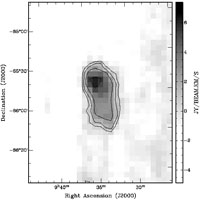 |
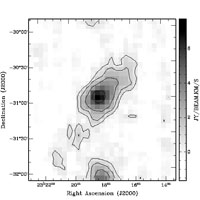 |
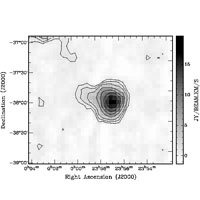 |
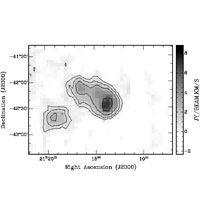 |
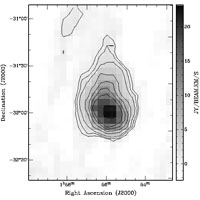 |
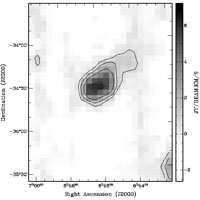 |
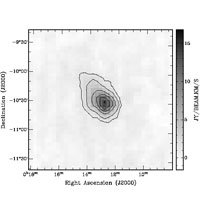 |
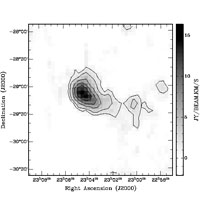 |
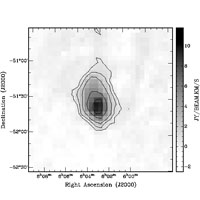 |
Figure 3. A sample of the 166 head-tail clouds found in the HIPASS survey of HVCs (Putman et al. 2002). The neutral hydrogen contours are 1.2 (3σ), 1.6, 2, 4, 8, 12, 16, and 20 × 1018 cm-2. |
||
In
Peek, Putman &
Sommer-Larsen (2008)
we examined the link between the observed HVCs and the clouds produced
in a high-resolution SPH cosmological simulation of galaxy
formation. The simulation includes chemical evolution,
supernova feedback, and radiative cooling with an extragalactic UV field
(see
Sommer-Larsen, Gotz &
Portinari 2003
for more details).
A resolution of 3 × 105
M for halo
clouds was reached by finding a Milky Way (Vc ~ 220 km
s-1, M ~ 1012
M
for halo
clouds was reached by finding a Milky Way (Vc ~ 220 km
s-1, M ~ 1012
M )
in a lower resolution simulation and then tracing it back and replacing one
particle with 12 at z = 0.4, and then one particle with 8
particles ~ 0.2 Gyr later.
The simulation was then run for another 0.5 Gyr and the halo
cloud population examined at several timesteps.
)
in a lower resolution simulation and then tracing it back and replacing one
particle with 12 at z = 0.4, and then one particle with 8
particles ~ 0.2 Gyr later.
The simulation was then run for another 0.5 Gyr and the halo
cloud population examined at several timesteps.
The simulated and observed halo clouds are found throughout the Galactic sky, at distances below 60 kpc. There has been substantial recent progress on constraining the distances to the observed HVCs using direct and indirect methods (e.g., Thom et al. 2008; Westmeier et al. 2007). The simulated clouds have an average Galactic Standard of Rest velocity of VGSR = -65 to -85 km s-1 (depending on the location of the Sun in the simulation), which is comparable to the observed HVC average velocity of VGSR = -85 km s-1. The mass of the simulated clouds can be converted to an observed flux with the known distance and by assuming a sensible ionized component (< 50% ionized). The simulated cloud fluxes (individual and total) are also found to be comparable to the observed HVCs. A large percentage of the flux from the simulated clouds comes from a few nearby complexes, which is also the case for the Galactic HVCs (i.e. Complex C). Peek et al. (2008) present the figures that support the comparisons discussed in this paragraph.
The observed and simulated halo clouds show many similarities,
indicating many
HVCs may represent clouds condensing from a hot halo medium. The accretion
rate of these clouds can be determined from the simulation and is found to
be ~ 0.2 M /yr
onto the galaxy's disk. Figure 4 shows the
infall rate of simulated clouds onto subsequent galactic radii.
The gradually increasing infall rate shows that clouds are created
and/or grow at all radii. The convergence of the infall rate at 0.2
M
/yr
onto the galaxy's disk. Figure 4 shows the
infall rate of simulated clouds onto subsequent galactic radii.
The gradually increasing infall rate shows that clouds are created
and/or grow at all radii. The convergence of the infall rate at 0.2
M /yr is at
z = 0 and this accretion rate is predicted to be much greater at
higher redshifts consistent with the higher star formation rate
(Sommer-Larsen et
al. 2003).
/yr is at
z = 0 and this accretion rate is predicted to be much greater at
higher redshifts consistent with the higher star formation rate
(Sommer-Larsen et
al. 2003).
 |
Figure 4. The accretion rate of clouds onto subsequent galactic radii in the simulation. The dotted line represents where the accretion rate can no long be accurately determined because the clouds are merging with the disk. See Peek et al. (2008) for details. |